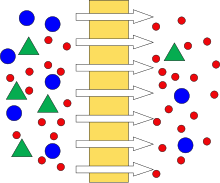Dead End Filtration
Under dead-end filtration refers to the classic form of filtration (as in coffee filter ). It is mostly used for flat membranes , but also more and more frequently for hollow fiber applications.
In contrast to tangential flow filtration (also known as cross-flow or cross-flow filtration), a filter cake forms with dead-end filtration . Therefore, dead-end filtration - like cake filtration , to which it is similar or identical - belongs to surface filtration .
principle
In dead-end filtration, a feed (will Feed ) is pumped against the membrane. The pressure is as low as possible (e.g. in water treatment using UF membranes approx. 1 bar) in order to minimize the compaction of the retained substances (the retentate ). Due to the permanent drainage of the permeate , a filter cake (top layer or fouling ) or a concentration gradient ( concentration polarization ) from the solid particles to be separated accumulates on the membrane.
The filter cake increases the filtration resistance and thus the pressure loss across the membrane. Therefore, depending on the feed composition, the filter cake must be removed at regular intervals by backwashing (pumping back of the medium that has already been separated off) and chemical cleaning agents , thus regenerating the filter element.
Areas of application
Preferred areas of application are areas in which low particle counts or lower concentration gradients are to be expected. Due to the permanent flow against the feed, the permeate flow decreases steadily and the backwashing results in a "sawtooth pattern" in the filtrate flow. Dead-end filtration is of great importance in water treatment , but also in many other areas of membrane technology :
In swimming pool treatment , all ultrafiltrations are operated in dead-end; in the case of rinsing wastewater treatment , it depends on the manufacturer whether dead-end or tangential flow filtration is used.
economics
Characteristic features of dead-end filtration are the ongoing production downturn and product losses due to backwashing. The use of cleaning agents and their disposal and storage associated with cleaning are also disadvantageous.
The higher energy efficiency of dead-end filtration is advantageous compared to cross-flow filtration, in which a large part of the energy invested in conveying the feed is lost through the retentate. That is why more and more dead-end filtration is used at those points where cross-flow filtration can be dispensed with. Another advantage of dead-end filtration is that it has a very simple structure and that the filtration operation can also be carried out by less qualified personnel.
literature
- Munir Cheryan: Handbook of Ultrafiltration . B. Behr's Verlag GmbH & Co, 1990, ISBN 3-925673-87-3 .
- Rautenbach, Robert: Membrane process basics of module and system design . Springer-Verlag, 1997, ISBN 3-540-61573-3 .
- Staude, Eberhard: Membranes and membrane processes . VCH Verlagsgesellschaft mbH, 1992, ISBN 3-527-28041-3 .


